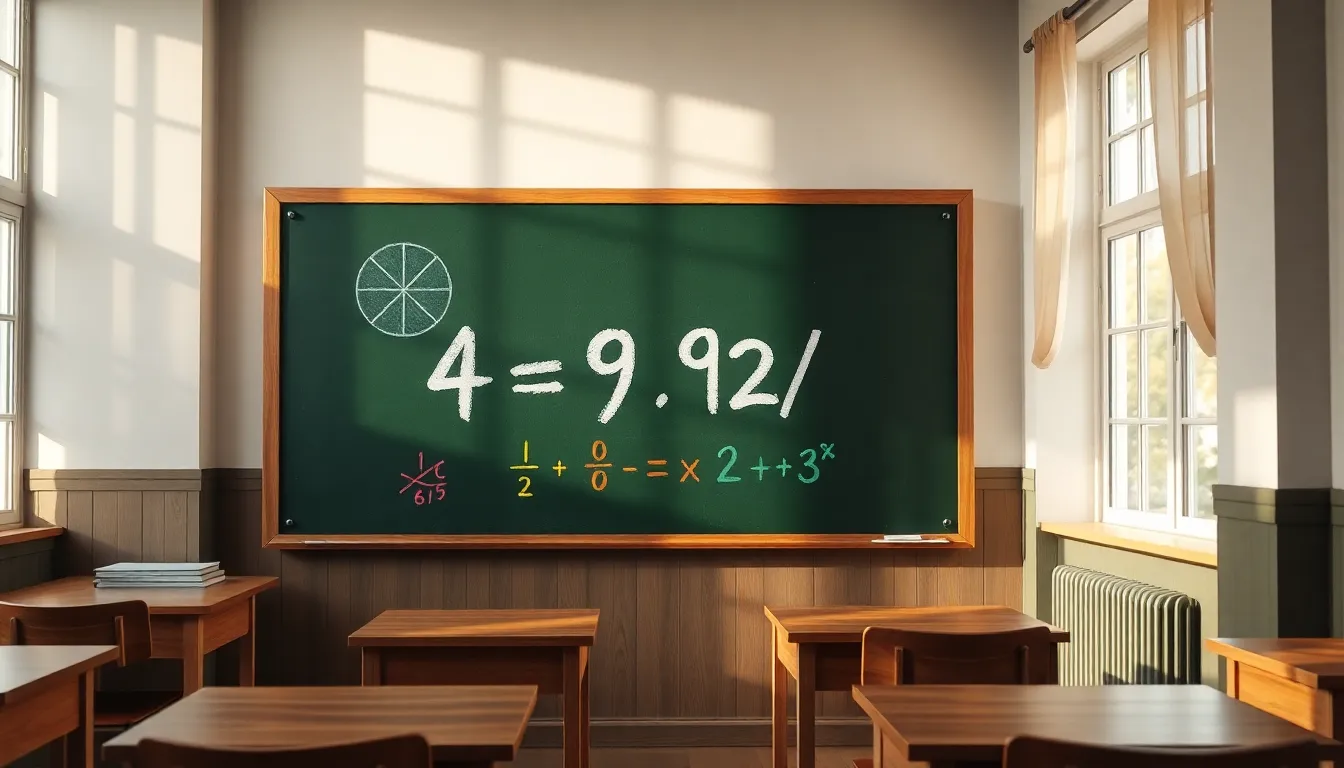Understanding division can sometimes feel tricky, especially when fractions come into play. When faced with the problem of dividing a whole number by a fraction, like 4 divided by 9/2, it’s essential to grasp the underlying principles to simplify the process.
This mathematical operation not only showcases the beauty of numbers but also highlights the importance of mastering basic arithmetic skills. By breaking down this equation step by step, anyone can unlock the mystery behind dividing whole numbers by fractions. Let’s dive into the world of division and uncover the solution to this intriguing problem.
Table of Contents
ToggleUnderstanding Division
Division serves as a fundamental mathematical operation, allowing individuals to determine how many times one number fits into another. When dividing fractions, a clear understanding of the process simplifies operations, as seen in the example of 4 divided by 9/2.
What Does Division Mean?
Division represents the process of distributing a quantity into equal parts. This operation involves two numbers: the dividend and the divisor. For instance, in the expression 4 ÷ (9/2), 4 serves as the dividend, while 9/2 acts as the divisor. The result, known as the quotient, indicates how many times the divisor fits into the dividend.
The Importance of Division in Mathematics
Division plays a critical role in various mathematical contexts. It enables problem-solving and analysis across many areas, including:
- Fractions: Understanding division of fractions aids in simplifying complex calculations.
- Proportions: Division helps identify relationships between different quantities, essential for solving ratio problems.
- Measurements: Dividing measurements allows for accurate scaling and conversions.
- Statistics: Division facilitates the computation of averages and statistical analysis.
Mastering division strengthens fundamental math skills, leading to increased confidence and capability in tackling more advanced topics.
Breaking Down the Problem

Dividing whole numbers by fractions can seem daunting. However, understanding the conversion and the division process simplifies the problem significantly.
Converting Mixed Numbers
Converting mixed numbers to improper fractions is crucial for effective division. A mixed number consists of a whole number and a fraction. To convert it, multiply the whole number by the denominator and add the numerator. For example, to convert 9/2, it remains as it is since it is already a fraction. The improper fraction for another example, 1 ½, converts to 3/2 (1 * 2 + 1 = 3; hence, 3/2).
The Division Process
The division of 4 by 9/2 involves multiplying 4 by the reciprocal of 9/2. The reciprocal of a fraction is obtained by swapping its numerator and denominator. Therefore, the division translates to:
[
4 div frac{9}{2} = 4 times frac{2}{9}
]
Performing the multiplication:
[
4 times frac{2}{9} = frac{8}{9}
]
This method demonstrates that dividing 4 by 9/2 results in 8/9, offering clarity in the division process and confirming the understanding of fractions.
Calculating 4 Divided by 9/2
Calculating 4 divided by 9/2 involves a straightforward method that simplifies the division process. This section breaks down the steps and simplifies the result.
Step-by-Step Calculation
- Identify the numbers: The dividend is 4 and the divisor is 9/2.
- Convert the division to multiplication: To divide by a fraction, multiply by its reciprocal. The reciprocal of 9/2 is 2/9.
- Multiply: Multiply 4 by 2/9.
- Calculation:
[
4 times frac{2}{9} = frac{4 times 2}{9} = frac{8}{9}
]
4. Result: The result of 4 divided by 9/2 equals 8/9.
Simplifying the Result
The fraction 8/9 is already in its simplest form. Checking for further simplification:
- Numerator: 8
- Denominator: 9
Since 8 and 9 share no common factors other than 1, 8/9 remains the final answer. Thus, 4 divided by 9/2 results in a simplified fraction of 8/9.
Applications of the Result
The result of dividing 4 by 9/2, which is 8/9, holds various applications in real-world scenarios and higher mathematics. Understanding these applications reveals the significance of fractional division.
Real-World Uses of Division
Division plays a critical role in everyday calculations. Examples include:
- Cooking and Baking: When adjusting recipes that require fractional measurements, understanding how to divide ingredients becomes essential. For instance, if a recipe calls for 4 cups of flour and one needs to adapt it to serve fewer people, dividing the original amount by a fraction simplifies the measurement process.
- Financial Calculations: In budgeting, determining how expenses relate to income involves dividing total costs by fractions of income. For instance, if one spends $4 for every $9 earned, dividing the expenses helps track spending.
- Construction and Measurement: Builders use division when determining material quantities, such as how many 9/2-foot sections fit into a total length of 4 feet. This practical application ensures resources are accurately calculated.
Importance in Higher Mathematics
Division of fractions, like that of 4 by 9/2, is foundational for higher mathematical concepts. Key areas impacted include:
- Algebra: In solving for unknown variables, the ability to manipulate fractions through division allows for simplification of complex equations. Mastery of division enhances capabilities in algebraic problem-solving.
- Calculus: Understanding limits and functions within calculus involves division. The comprehension of fraction division aids in evaluating functions, optimizing problems, and handling derivatives.
- Statistics: Division facilitates calculations in statistical analysis, particularly when computing averages, ratios, or probabilities. The result of fraction division is essential for valid data interpretation and analysis.
Emphasizing these applications connects the conceptual understanding of division to practical and theoretical uses, solidifying its relevance across diverse contexts.
Mastering the division of whole numbers by fractions is crucial for developing strong mathematical skills. The example of 4 divided by 9/2 illustrates how this process can be simplified through the use of reciprocals. Arriving at the result of 8/9 not only reinforces understanding but also highlights the practical applications of such calculations in everyday life.
Whether adjusting recipes or managing budgets, the ability to divide fractions effectively empowers individuals to tackle various challenges. This knowledge forms a foundation for more advanced mathematical concepts, ensuring confidence in both theoretical and real-world scenarios. Embracing these skills opens doors to a deeper appreciation of mathematics and its significance in daily activities.








